Overview
The three primary categories of analytics techniques—descriptive analytics, diagnostic analytics, and predictive analytics—are designed to extract significant value from data, each serving distinct purposes in the realm of data analysis. This article explores how these techniques are applied across various sectors, providing insights into past performance, uncovering the reasons behind outcomes, and forecasting future trends. Such applications not only enhance decision-making but also improve operational efficiency. By understanding these analytics types, professionals can better navigate their data landscapes and leverage insights for strategic advantage.
Introduction
In an age where data reigns supreme, organizations are increasingly turning to analytics as a vital tool for enhancing decision-making and operational efficiency. Analytics provides a treasure trove of information—from descriptive insights that reveal historical trends to predictive models that forecast future outcomes—driving strategic growth. Yet, the journey to effective data utilization is fraught with challenges, including data quality issues and resistance to change within teams.
This article explores the various types of analytics—descriptive, diagnostic, predictive, and prescriptive—illustrating how tailored solutions can empower businesses to overcome obstacles and unlock the full potential of their data. By examining real-world applications and expert insights, it becomes evident that embracing a structured approach to analytics is not merely advantageous; it is essential for sustained success in today’s competitive environment.
Understanding Analytics: The Key to Data-Driven Decision Making
Analytics encompasses the systematic computational examination of information and statistics, serving as a fundamental pillar in today’s corporate landscape. It empowers organizations to make informed, data-driven decisions that significantly enhance operational efficiency and strategic planning. By thoroughly analyzing both historical and contemporary data, companies can identify patterns, trends, and insights essential for developing effective strategies.
The significance of data analysis is underscored by recent findings, indicating that 91% of businesses recognize data-driven decision-making as crucial to their success, according to a recent survey. However, only 57% of these organizations actually base their decisions on data, revealing a critical gap in implementation. This discrepancy emphasizes the necessity for a structured approach to analytics, as illustrated in the case study titled “Streamlining Operations with GUI Automation.” Here, a mid-sized company faced challenges such as manual data entry errors, slow software testing, and difficulty integrating outdated systems without APIs.
The implementation of GUI automation resulted in a 70% reduction in data entry errors, a 50% acceleration in testing processes, and an 80% improvement in workflow efficiency, showcasing the transformative impact of automation on operational efficiency. Notably, the company achieved a return on investment (ROI) within six months of implementing the solution.
Moreover, organizations that have initiated projects aimed at reducing expenses have reported substantial value, with over 49% experiencing positive outcomes from these initiatives. This statistic illustrates the tangible advantages of incorporating data analysis into operational frameworks. As companies navigate the complexities of the data environment in 2025, effective execution of data analysis not only enhances operational efficiency but also fosters a culture of informed decision-making.
Expert opinions further reinforce the importance of data analysis, with industry leaders advocating for its role in enhancing operational efficiency. For instance, Atlan reported that more than half of companies are increasing their budgets in 2023, in contrast to only 8% indicating budget reductions, signifying a growing awareness of the importance of data analysis. Additionally, testimonials from clients, such as Sascha Rudloff from PALFINGER Tail Lifts GMBH, highlight how Creatum’s Power BI Sprint has significantly improved their analysis capabilities, further emphasizing the significance of business intelligence in fostering informed decision-making.
By leveraging analysis, organizations can transform raw data into actionable insights, ultimately leading to enhanced performance and strategic development. In this data-rich era, the ability to effectively utilize data insights is not merely an advantage; it is essential for sustained success.

Descriptive Analytics: Summarizing Historical Data for Insights
Descriptive analysis is pivotal in understanding the three broad categories of analytics techniques that transform raw data into meaningful insights through aggregation and mining techniques, thereby illuminating past performance. This analytical approach addresses the essential question: what are the three broad categories of analytics techniques designed to extract value from data? It summarizes historical information using key metrics such as averages, totals, and percentages.
For instance, a retail firm may leverage descriptive analysis to scrutinize sales data from the previous year, revealing patterns in customer buying behavior that can inform future strategies.
In 2023, the retail sector increasingly recognized the significance of descriptive analytics, with 56% of analytics leaders reporting budget increases, while 36% noted their budgets remained unchanged. This trend underscores a robust commitment to data-driven decision-making. As Atlan observes, “Over half are increasing budgets in 2023 compared to just 8% who report decreasing their budgets.”
This trend is particularly noteworthy as the number of connected IoT devices surged to 16 billion, projected to reach 20.3 billion by 2025, generating a staggering 79.4 zettabytes of data. Such immense volumes of information, characterized by high velocity and wide variation, present both opportunities and challenges for organizations.
When contemplating the three broad categories of analytics techniques aimed at extracting value from data, descriptive analytics methods such as visualization and reporting are crucial for effectively summarizing historical data. Retailers can employ these techniques to assess average metrics like sales per customer or inventory turnover rates, offering a clearer view of operational performance. Additionally, by utilizing Business Intelligence tools like Power BI from Creatum GmbH, organizations can enhance their data reporting capabilities, ensuring data consistency and actionable insights.
The 3-Day Power BI Sprint enables organizations to swiftly develop professionally designed reports, while the General Management App supports comprehensive management and insightful reviews. As companies continue to harness the power of descriptive analysis and BI, they can gain a deeper understanding of their historical performance, empowering them to make informed decisions that drive growth and enhance operational efficiency.
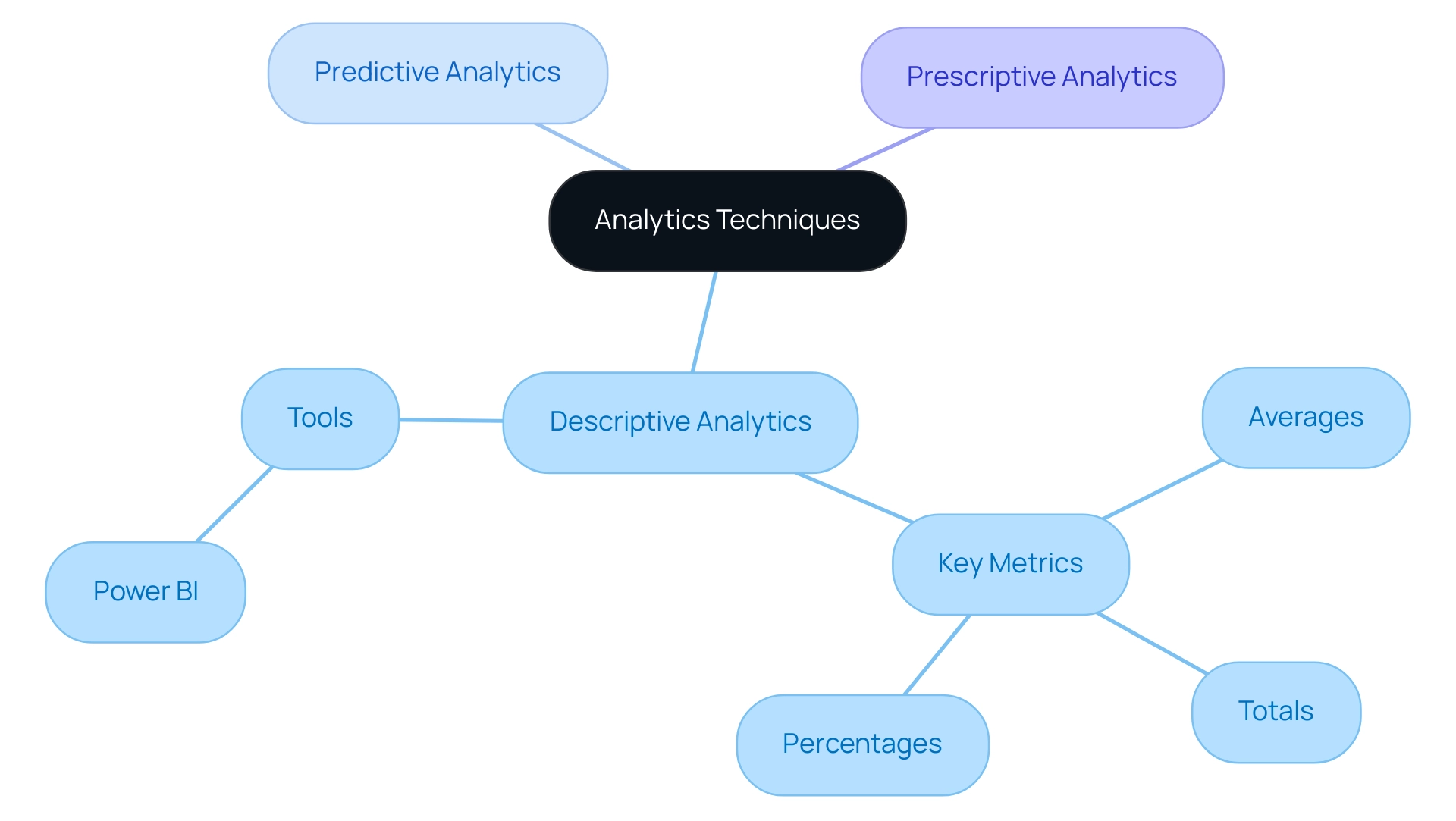
Diagnostic Analytics: Uncovering the Reasons Behind Outcomes
Diagnostic examination transcends superficial information assessment to confront the critical question, ‘Why did it occur?’ This analytical approach employs various techniques to uncover relationships and causations within datasets, addressing the three broad categories of analytics techniques designed to extract value from data. For instance, when a company faces a sales decline, diagnostic analysis proves instrumental in examining customer feedback and sales trends.
This process can reveal underlying issues such as product quality concerns or deficiencies in customer service.
The effectiveness of diagnostic analysis is underscored by its potential to enhance revenue by up to 20% in marketing and sales processes. Companies like Canadian Tire have adeptly utilized ThoughtSpot AI-Powered Analytics to identify cross-selling opportunities, resulting in a remarkable 20% increase in sales. Similarly, HelloFresh leverages diagnostic analytics to gain insights into customer behavior, focusing particularly on understanding the reasons behind subscription cancellations, ultimately enhancing user experience.
In this rapidly evolving AI landscape, harnessing Robotic Process Automation (RPA) can further bolster operational efficiency by automating manual workflows, allowing teams to concentrate on strategic, value-adding tasks.
Creatum GmbH’s tailored AI solutions cut through the noise, delivering targeted technologies that align with specific organizational goals and challenges.
A compelling case study is Amplitude Analytics, which functions as a diagnostic tool offering Root Cause Analysis (RCA) capabilities. By utilizing Amplitude, organizations can transform information into strategic advantages, facilitating informed decision-making across various sectors. This highlights the significance of diagnostic analysis in uncovering organizational challenges and fostering enhancements.
Moreover, the value of Business Intelligence is amplified through Creatum GmbH’s Power BI offerings, which enhance reporting and provide actionable insights. The 3-Day Power BI Sprint enables the rapid creation of professionally designed reports, while the General Management App offers comprehensive management and smart reviews, addressing data inconsistency and governance challenges in reporting for improved decision-making.
Industry experts assert that diagnostic analysis is crucial for retail leaders, as it allows them to comprehend customer behaviors, including purchasing trends and the factors influencing buying decisions. By effectively employing diagnostic analysis alongside RPA and Power BI, companies can explore the three broad categories of analytics techniques designed to extract value from data, identify common causes of sales decline, and implement targeted strategies to enhance customer service and overall operational efficiency. Client testimonials further underscore the transformative impact of Creatum’s technology solutions in driving business growth and operational efficiency.
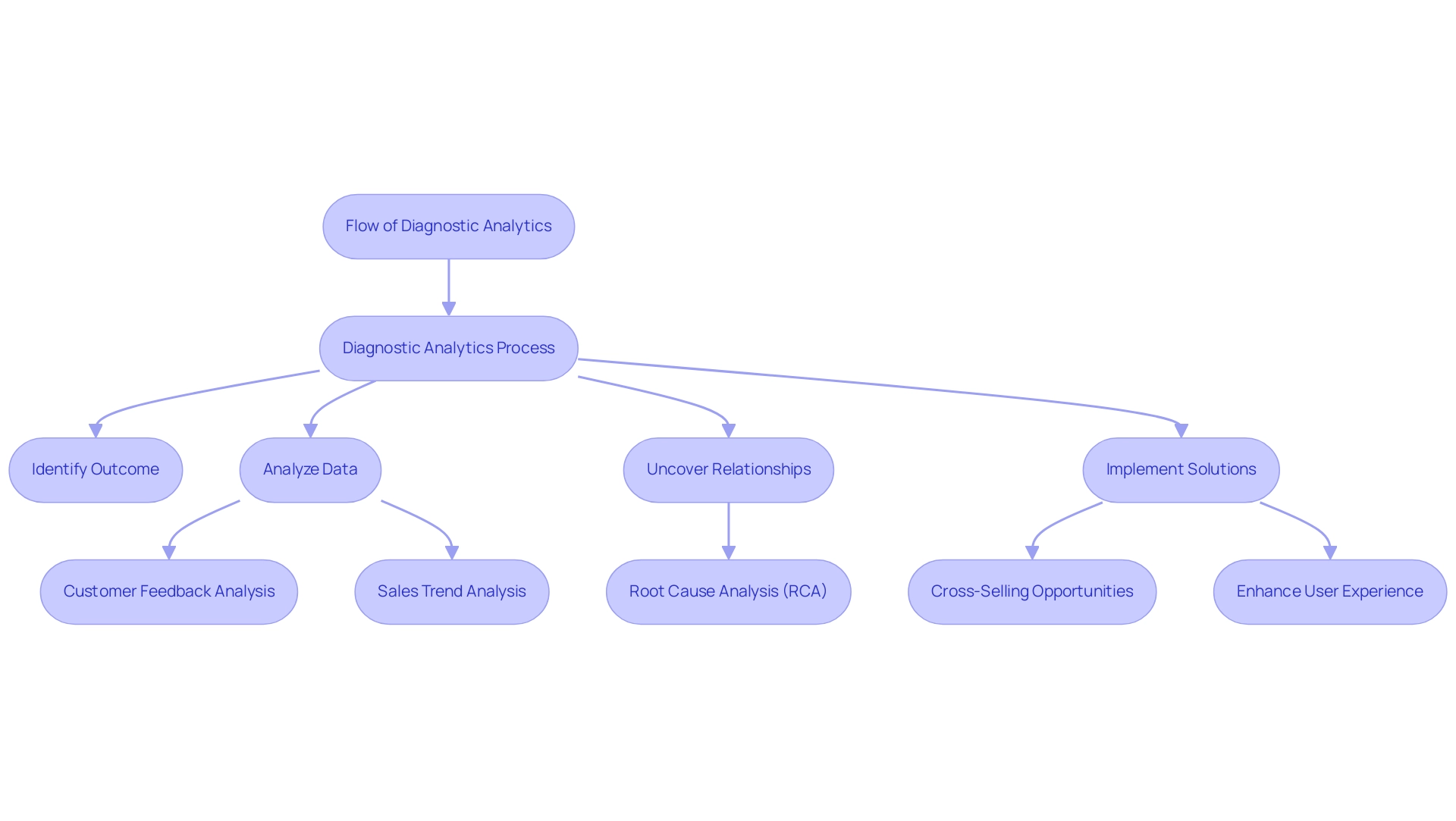
Predictive Analytics: Forecasting Future Trends from Historical Data
Predictive analysis employs statistical algorithms and machine learning techniques to scrutinize historical data, enabling organizations to forecast future outcomes with greater accuracy. This approach addresses the critical question, ‘What is likely to happen?’ For instance, financial institutions utilize predictive analysis to assess the likelihood of loan defaults by examining past borrowing behaviors alongside economic indicators.
This method has demonstrated effectiveness, with studies showing that predictive techniques can enhance forecasting accuracy by up to 20%, significantly improving decision-making processes.
Across industries, the adoption of predictive methods is on the rise, particularly in the healthcare sector. Reports indicate that a significant percentage of healthcare organizations are embracing predictive methods to forecast disease outbreaks and optimize treatment plans. This trend underscores the importance of predictive analysis in identifying high-risk patients and implementing proactive intervention programs, ultimately improving patient outcomes.
A notable example is Massachusetts General Hospital, which successfully utilized predictive methods to enhance patient care through targeted interventions.
In the finance sector, predictive techniques play a pivotal role in risk assessment. Financial analysts emphasize its importance, noting that it allows institutions to anticipate market fluctuations and adjust strategies accordingly. Businesses are increasingly employing predictive models to assess credit risk, enabling informed lending decisions and minimizing potential losses.
As one financial analyst stated, ‘Predictive data analysis is not just a tool; it’s a necessity for navigating today’s volatile market.’ Current trends suggest that by 2025, predictive analysis will continue to evolve, with improvements in information architecture and governance becoming crucial for securely and efficiently handling health information. This change is essential as institutions strive to uphold information quality while ensuring adherence to privacy regulations.
Healthcare organizations are prioritizing strong information structures to enhance their predictive capabilities, reflecting a broader trend among industry players launching new products and improving their portfolios to strengthen market position.
Case studies further illustrate the transformative impact of predictive analysis. Planet Fitness, for example, collaborated with Coherent Solutions to improve customer insights through advanced information analysis, leading to a thorough understanding of member behaviors. This initiative not only enhanced customer satisfaction but also nurtured long-term loyalty by facilitating personalized services tailored to individual preferences.
As predictive data analysis continues to gain traction, its applications across various sectors will broaden, driving innovation and improving operational efficiency. Furthermore, integrating tools like the General Management App, featuring Microsoft Copilot for smart reviews and custom dashboards, can significantly streamline reporting and enhance decision-making processes. By utilizing AI solutions, including Small Language Models and GenAI Workshops, organizations can improve information quality and tackle governance challenges, ensuring that predictive analysis remains a cornerstone of strategic planning.
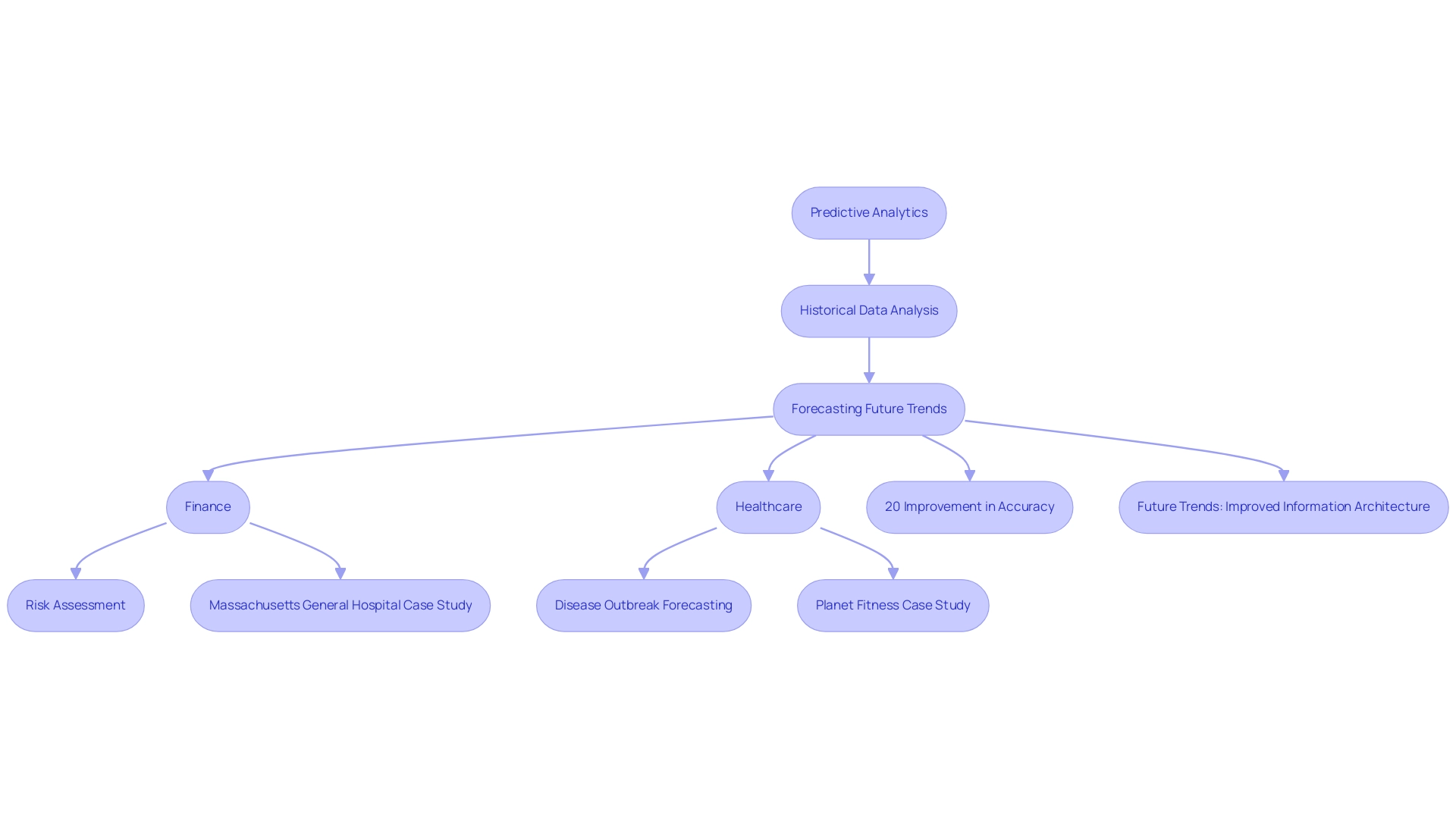
Prescriptive Analytics: Guiding Decision-Making with Data-Driven Recommendations
Prescriptive analysis transcends mere prediction by actively recommending specific actions to achieve desired outcomes, effectively answering the question, ‘What should we do?’ This analytical approach employs optimization and simulation algorithms to assess various scenarios and their potential results. In 2025, a prominent logistics company utilized prescriptive analysis to enhance delivery routes, considering real-time traffic information and delivery schedules. This not only reduced delivery times but also significantly cut operational costs.
Statistics reveal that organizations utilizing prescriptive methods experience a 20% increase in decision-making efficiency, underscoring its effectiveness in dynamic environments characterized by diverse data sources. Logistics specialists stress that prescriptive data analysis enhances operational efficiency by offering actionable insights that guide strategic decisions. A notable case study involved a major shipping company that employed prescriptive methods to streamline its supply chain operations, resulting in a 15% reduction in delays and enhanced customer satisfaction.
However, decision automation in prescriptive analysis faces challenges due to uncertainty and complexity, which can hinder its effectiveness. Recent advancements in prescriptive analysis have shown promising results in guiding decision-making processes. Businesses are increasingly adopting these techniques to navigate complex logistical challenges, such as inventory management and demand forecasting.
Expert opinions emphasize that the incorporation of prescriptive data analysis, along with Robotic Process Automation (RPA) and customized AI solutions from Creatum GmbH, not only enhances operational efficiency but also promotes a culture of data-driven decision-making. This ultimately propels growth and innovation in the logistics sector. As Catherine Cote, Marketing Coordinator at Harvard Business School Online, states, “Do you want to become a data-driven leader?” This sentiment aligns with the necessity for entities to adopt data analysis in their operations.
Moreover, the literature review process has identified significant developments in prescriptive analysis, focusing on publications from 2010 to 2019, which underscores the growing importance of this analytical approach. Innovative methods, such as coupling complex event processing (CEP) with probabilistic logic, have been proposed to enhance prescriptive analytics, enabling entities to proactively prescribe actions based on predictions. By leveraging RPA tools such as EMMA RPA and Microsoft Power Automate, organizations can automate manual workflows, enhance employee morale, and ultimately transform their operations for greater efficiency and effectiveness.
Client testimonials from organizations that have implemented these solutions highlight the tangible benefits achieved, reinforcing the value of Creatum GmbH’s offerings in enhancing operational efficiency.

Real-World Applications: Leveraging Analytics for Business Success
What are the three broad categories of analytics techniques designed to extract value from data, and how do they play a pivotal role in driving success across multiple sectors, particularly when enhanced by Robotic Process Automation (RPA) and Business Intelligence? In retail, for instance, descriptive analysis is instrumental in identifying sales trends, enabling businesses to tailor their strategies effectively. RPA can automate manual workflows, significantly boosting operational efficiency and allowing teams to focus on strategic initiatives.
Diagnostic examination goes a step further by uncovering the underlying reasons for customer churn, allowing retailers to implement targeted retention strategies.
In the finance sector, predictive analytics is extensively utilized for risk assessment, assisting businesses in anticipating potential challenges and making informed decisions. The integration of customized AI solutions can further enhance information quality, addressing inconsistencies that may hinder effective reporting. For example, small language models and GenAI workshops offered by Creatum GmbH can enhance data analysis and privacy, ensuring that organizations have the tools they need to succeed.
Meanwhile, prescriptive analysis is crucial in supply chain management, where it optimizes inventory levels to meet demand without overstocking.
The profound impact of these analytics techniques can be seen across various industries. For instance, Geico has effectively raised its customer retention rate by 5% through the strategic use of data analysis. Similarly, Wells Fargo has reduced customer complaints by 10% by utilizing data analysis to enhance customer service, showcasing the tangible benefits of data-driven decision-making.
Case studies further demonstrate the effectiveness of data analysis in various industries. Barclays, for example, employs insights from data analysis to make strategic decisions concerning product offerings and market expansions based on risk profiles. This careful balance of risk and opportunity is essential for sustainable growth in the competitive banking sector, illustrating how data analysis aids in strategic decision-making and risk management.
As the importance of data analysis continues to expand, it raises the question of what are the three broad categories of analytics techniques designed to extract value from data, generating new opportunities across sectors. Business leaders acknowledge this trend; as Chandan Mishra, Head of Marketing at SCIKIQ, points out, ‘Data examination is key to Cyber Insurance as well.’ This emphasizes the growing significance of data analysis in various sectors.
The incorporation of data analysis, powered by RPA and Business Intelligence, not only enhances operational efficiency but also fosters innovation, ultimately driving growth and success in today’s data-rich environment. Moreover, Creatum GmbH’s Power BI services, including the 3-Day Sprint for report creation, illustrate how businesses can obtain actionable insights and enhance decision-making processes, reinforcing the transformative impact of advanced data solutions.
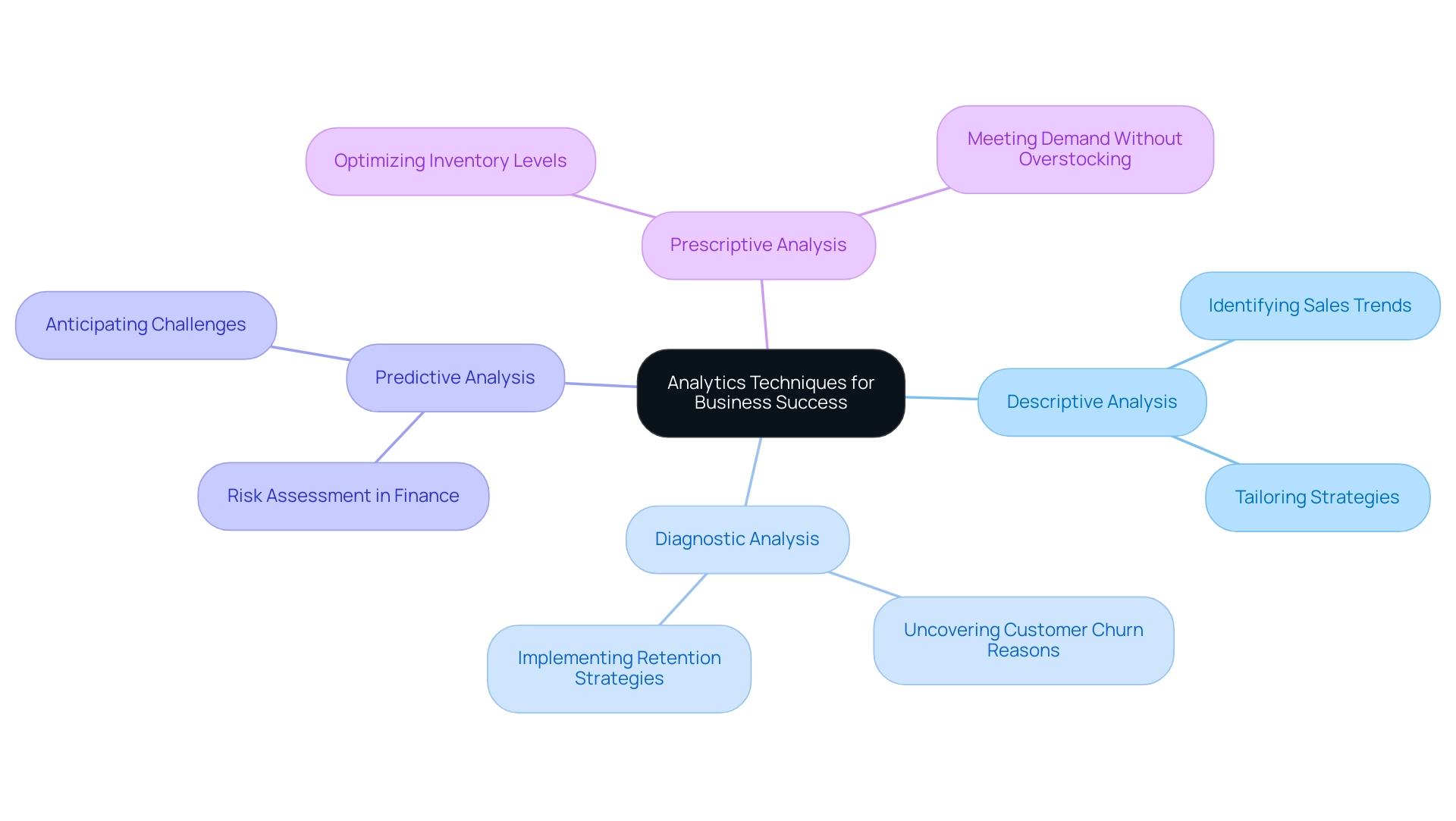
Overcoming Challenges: Enhancing Operational Efficiency through Analytics
Integrating data analysis within organizations often encounters significant challenges that can impede success. A primary concern is information quality; without precise and trustworthy information, the insights derived from analysis can be misleading or entirely incorrect. As Leigh Pearce emphasizes, the process of data consolidation—bringing together information from various sources such as databases, spreadsheets, and cloud services—can be intricate and time-consuming, complicating the examination process.
Moreover, resistance to change from employees poses a substantial barrier. Many individuals may be hesitant to adopt new technologies or methodologies, particularly if they are accustomed to traditional ways of working. To combat this, organizations must cultivate a culture that embraces data-driven decision-making.
This cultural shift is essential for overcoming resistance and ensuring that data analysis is integrated into everyday operations. Training and resources play a critical role in empowering employees to utilize data insights effectively. By equipping teams with the necessary skills—such as information management, advanced modeling, business case development, and domain knowledge—organizations can enhance operational efficiency and drive business success. Statistics indicate that entities emphasizing education in analysis experience a significant enhancement in their capacity to leverage information for strategic decision-making.
Furthermore, the expansion of the Internet of Things (IoT) illustrates the rising complexity of information management. With projections of 20.3 billion connected devices producing 79.4 zettabytes of information by 2025, companies must navigate this vast landscape to remain competitive. Thriving entities are those that not only tackle information quality challenges but also establish robust analytical frameworks capable of adapting to the evolving informational landscape.
By utilizing IoT solutions and Robotic Process Automation (RPA) from Creatum GmbH, entities can effectively manage information complexity and enhance their analytical capabilities, boosting operational efficiency and informed decision-making.
In summary, addressing the challenges of executing analytical processes necessitates a multifaceted approach that prioritizes information quality, fosters a supportive culture, and invests in employee training. Additionally, understanding the three broad categories of analytics techniques designed to extract value from data can provide entities with a clearer framework for their analytical strategies. By addressing these areas and leveraging tailored AI solutions from Creatum GmbH, organizations can unlock the full potential of their data, leading to informed decision-making and sustained growth.
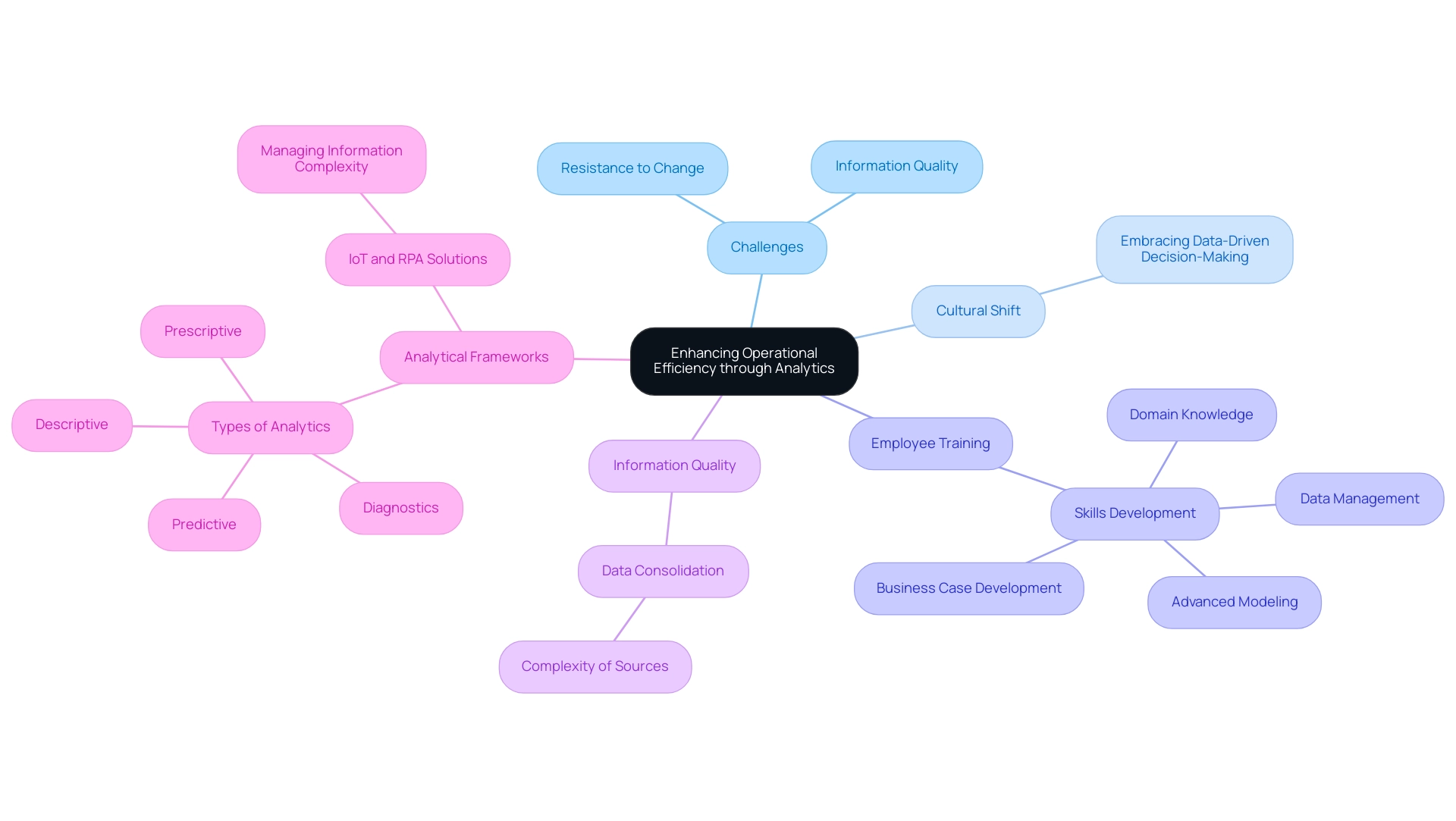
Tailored Analytics Solutions: Customizing Approaches for Optimal Results
Customized data solutions are essential for organizations aiming to confront unique challenges and achieve specific objectives. By personalizing data analysis methods, businesses can effectively employ the right techniques and tools to meet their distinct needs. For example, in the healthcare sector, specialized predictive models can anticipate patient outcomes, significantly enhancing the quality of care.
According to the Healthcare Information and Management Systems Society, a notable 78% of organizations utilizing performance analysis reported marked improvements in patient care quality. This statistic underscores the profound impact of tailored data analysis in this field.
In the retail sector, customized prescriptive data insights can optimize inventory management, ensuring stock levels align with consumer demand. This strategy not only improves operational efficiency but also boosts customer satisfaction. A recent case study involving Planet Fitness and Coherent Solutions illustrates this, as they developed a comprehensive data solution that provided a 360-degree view of fitness club members.
This initiative led to customized services, heightened customer satisfaction, and fostered long-term loyalty by understanding clients’ needs.
The effectiveness of tailored data solutions is further supported by statistics indicating that 48% of early adopters in the United States and Canada prioritize enhancing data-analyst efficiency as their primary motivation for adopting generative AI. This highlights the growing recognition of the importance of tailored insights in improving operational capabilities. Moreover, entities such as JPMorgan Chase have successfully utilized large-scale analytics to refine loan underwriting precision and reduce default rates, showcasing the tangible benefits of personalized analytics solutions in enhancing decision-making and business outcomes.
At Creatum GmbH, we acknowledge the complexities of the AI landscape and provide customized AI solutions that cut through the noise, aligning with your specific business goals and challenges. Our key offerings include:
- Small Language Models for efficient information analysis and enhanced privacy
- GenAI Workshops that provide hands-on training and custom GPT creation
- Business Intelligence services that empower organizations to harness the potential of data, transforming raw information into actionable insights that drive growth and innovation
Additionally, our Robotic Process Automation (RPA) solutions streamline workflows, enhance efficiency, and minimize errors, enabling your team to concentrate on strategic, value-added tasks. Expert insights emphasize the importance of understanding the three broad categories of analytics techniques designed to extract value from data, as this coordination enhances information quality, improves decision-making, and ultimately propels growth. By adopting tailored analytics approaches, organizations can convert raw data into actionable insights, resulting in informed decision-making and improved organizational outcomes.
Furthermore, our Power BI services, including the 3-Day Power BI Sprint for rapid report creation and the General Management App for comprehensive oversight, ensure efficient reporting and clear, actionable guidance. Client testimonials further underscore the impact of Creatum GmbH’s technology solutions in enhancing operational efficiency and driving business growth.
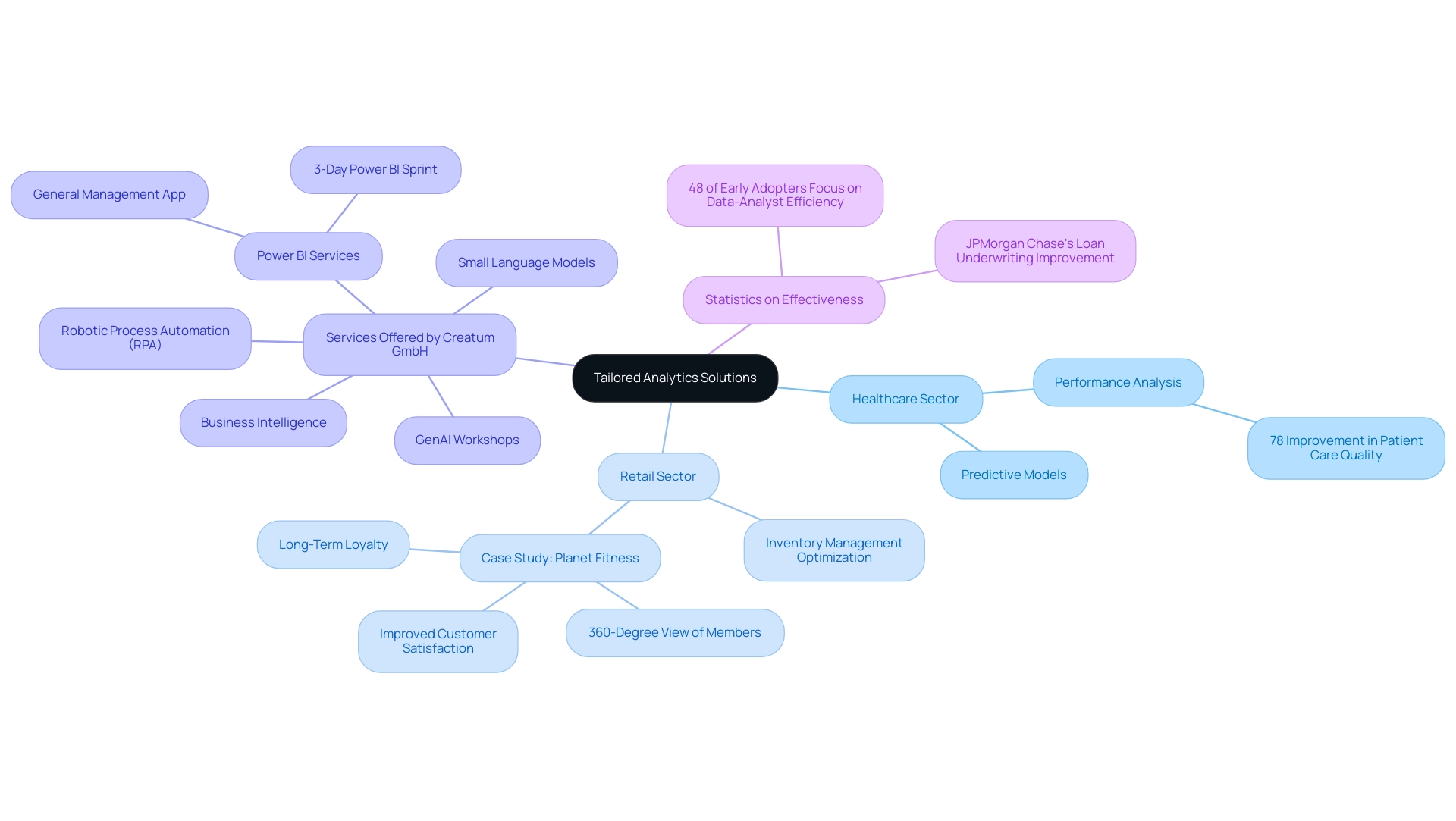
Conclusion
In today’s data-driven landscape, the strategic implementation of analytics is paramount for organizations aiming to enhance decision-making and operational efficiency. This article has illuminated the various types of analytics—descriptive, diagnostic, predictive, and prescriptive—each playing a distinct role in transforming raw data into meaningful insights. By leveraging these analytical techniques, businesses can not only identify historical trends but also uncover the reasons behind outcomes, forecast future scenarios, and develop actionable recommendations that drive growth.
Furthermore, the challenges associated with analytics, such as data quality issues and resistance to change, underscore the importance of fostering a culture that embraces data-driven methodologies. Investing in employee training and adopting tailored analytics solutions can significantly enhance an organization’s ability to navigate the complexities of the data landscape. Successful case studies demonstrate that organizations which effectively implement analytics frameworks can achieve remarkable operational improvements, as evidenced by enhanced customer satisfaction and increased efficiency.
Ultimately, embracing a structured and customized approach to analytics is essential for sustained success in a competitive environment. As organizations continue to evolve, the integration of analytics will serve as a critical enabler, empowering them to make informed decisions that align with their strategic objectives. The journey toward effective data utilization is ongoing; however, with the right tools and mindset, businesses can unlock the full potential of their data, paving the way for innovation and growth in the future.
Frequently Asked Questions
What is analytics and why is it important for organizations?
Analytics is the systematic computational examination of information and statistics, which helps organizations make informed, data-driven decisions. It enhances operational efficiency and strategic planning by identifying patterns, trends, and insights from historical and contemporary data.
How many businesses recognize the importance of data-driven decision-making?
According to recent findings, 91% of businesses recognize data-driven decision-making as crucial to their success.
What is the gap in data-driven decision-making among organizations?
While 91% of businesses acknowledge the importance of data-driven decision-making, only 57% actually base their decisions on data, highlighting a critical gap in implementation.
What are some benefits of implementing GUI automation in organizations?
Implementing GUI automation can lead to significant improvements, such as a 70% reduction in data entry errors, a 50% acceleration in testing processes, and an 80% improvement in workflow efficiency.
What was the return on investment (ROI) for the mid-sized company that implemented GUI automation?
The company achieved a return on investment (ROI) within six months of implementing the GUI automation solution.
How have organizations that initiated cost-reduction projects fared?
Over 49% of organizations that started projects aimed at reducing expenses reported positive outcomes, demonstrating the tangible benefits of incorporating data analysis into their operations.
What trends are emerging regarding budgets for data analysis in 2023?
More than half of companies are increasing their budgets for data analysis in 2023, indicating a growing awareness of its importance, while only 8% are reducing their budgets.
What role does descriptive analysis play in data analytics?
Descriptive analysis helps summarize historical information using key metrics such as averages, totals, and percentages, allowing organizations to understand past performance and inform future strategies.
How can retailers utilize descriptive analytics?
Retailers can analyze sales data from previous years to identify patterns in customer buying behavior, which can guide future strategies and operational decisions.
What tools can enhance data reporting capabilities for organizations?
Business Intelligence tools like Power BI from Creatum GmbH can enhance data reporting capabilities, ensuring data consistency and providing actionable insights for better decision-making.

